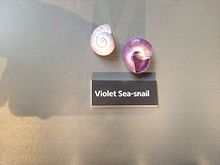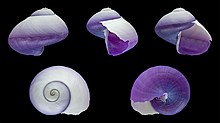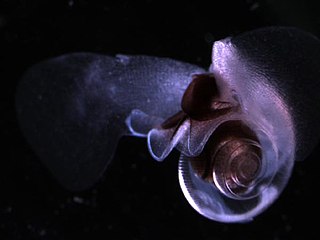
The Thecosomata, or sea butterflies, are a taxonomic suborder of small, pelagic, free-swimming sea snails known as holoplanktonic opisthobranch gastropod mollusks, in the order Pteropoda. Most pteropods have some form of calcified shell, although it is often very light, even translucent.

Limacina is a genus of swimming predatory sea snails commonly known as sea butterflies in the family Limacinidae. This genus contains some of the world's most abundant gastropod species.

Velella is a monospecific genus of hydrozoa in the Porpitidae family. Its only known species is Velella velella, a cosmopolitan free-floating hydrozoan that lives on the surface of the open ocean. It is commonly known by the names sea raft, by-the-wind sailor, purple sail, little sail, or simply Velella.

Glaucus atlanticus is a species of sea slug in the genus Glaucus.

Atlantidae is a family of sea snails, holoplanktonic gastropod molluscs in the clade Littorinimorpha.

Atlanta is a genus of pelagic marine gastropod molluscs in the family Atlantidae. They are sometimes called heteropods.

Peringia ulvae, common name the Laver spire shell or mudsnail, is a European species of very small aquatic snail with gills and an operculum, a gastropod mollusk in the family Hydrobiidae.
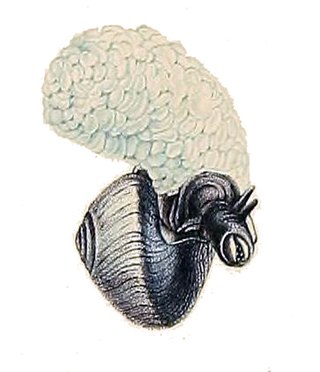
Janthina is a genus of small to medium-sized pelagic or planktonic sea snails, marine gastropod molluscs in the family Epitoniidae.

Porpita porpita, or the blue button, is a marine organism consisting of a colony of hydroids found in the warmer, tropical and sub-tropical waters of the Pacific, Atlantic, and Indian oceans, as well as the Mediterranean Sea and eastern Arabian Sea. It was first identified by Carl Linnaeus in 1758, under the basionym Medusa porpita. In addition, it is one of the two genera under the suborder Chondrophora, which is a group of cnidarians that also includes Velella. The chondrophores are similar to the better-known siphonophores, which includes the Portuguese man o' war, or Physalia physalis. Although it is superficially similar to a jellyfish, each apparent individual is actually a colony of hydrozoan polyps. The taxonomic class, Hydrozoa, falls under the phylum Cnidaria, which includes anemones, corals, and jellyfish, which explains their similar appearances.

The Pterotracheoidea is, according to the Taxonomy of the Gastropoda, a taxonomic superfamily of sea snails or sea slugs, marine gastropod molluscs in the clade Littorinimorpha. They are commonly called heteropods or sea elephants.

Janthina exigua, also known as the dwarf janthina, is a species of small holoplanktonic sea snail, a marine gastropod mollusk in the family Epitoniidae, the violet snails or purple storm snails.
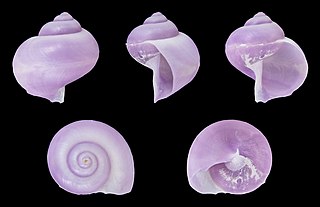
Janthina umbilicata, also known as the elongate janthina, is a species of holoplanktonic sea snail, a marine gastropod mollusk in the family Epitoniidae, the violet snails or purple storm snails.

Janthina pallida, also known as the pale janthina, is a species of holoplanktonic sea snail, a marine gastropod mollusk in the family Epitoniidae, the violet snails or purple storm snails.
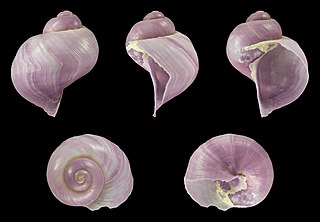
Janthina globosa is a species of holoplanktonic sea snail, a marine gastropod mollusk in the family Epitoniidae, the violet snails or purple storm snails.

Calyptraea chinensis, common name the Chinese hat snail or Chinese hat shell, is a species of small sea snail, a marine gastropod mollusk in the family Calyptraeidae, the slipper snails or slipper limpets, cup-and-saucer snails, and Chinese hat snails.

Oxygyrus keraudrenii is a species of sea snail, a holoplanktonic marine gastropod mollusk in the family Atlantidae.

Clio pyramidata is a species of sea butterfly, a floating and swimming sea snail, a pelagic marine gastropod mollusk in the family Cliidae.

Waldo is a genus of small marine clams in the family Galeommatidae. It includes five species which are all obligate commensals of sea urchins. They are found in the southern Atlantic and Antarctic Oceans, with the exception of Waldo arthuri which is found in the northeastern Pacific Ocean.
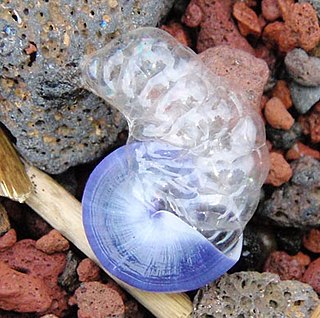
Janthinoidea is a superfamily of sea snails containing wentletraps (Epitoniidae) and surfing snails (Janthinidae). It includes species that have tethered egg masses, some of which are used for flotation.

Organisms that live freely at the ocean surface, termed neuston, include keystone organisms like the golden seaweed Sargassum that makes up the Sargasso Sea, floating barnacles, marine snails, nudibranchs, and cnidarians. Many ecologically and economically important fish species live as or rely upon neuston. Species at the surface are not distributed uniformly; the ocean's surface harbours unique neustonic communities and ecoregions found at only certain latitudes and only in specific ocean basins. But the surface is also on the front line of climate change and pollution. Life on the ocean's surface connects worlds. From shallow waters to the deep sea, the open ocean to rivers and lakes, numerous terrestrial and marine species depend on the surface ecosystem and the organisms found there.


